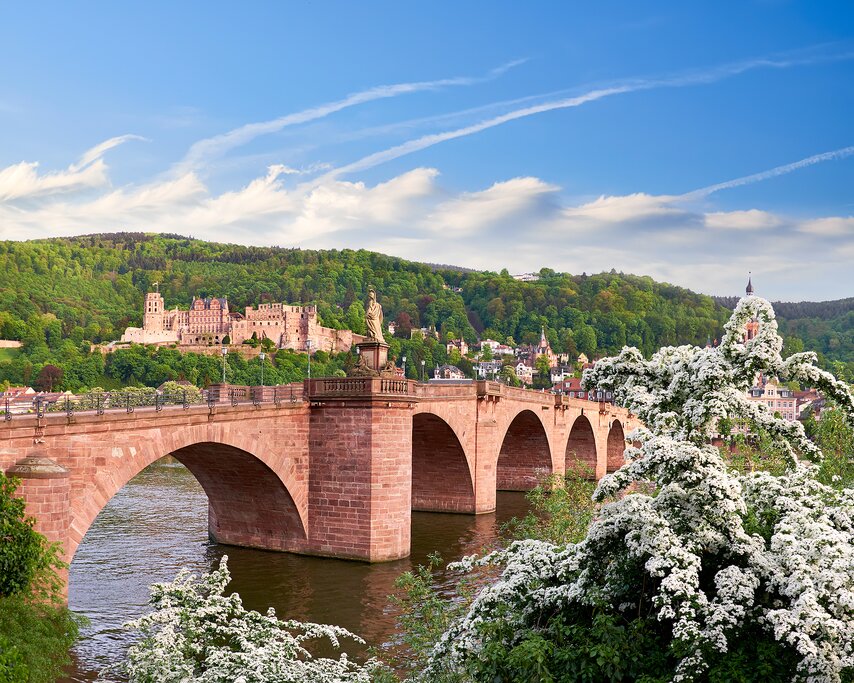Weather
April is an optimistic month when Germans (and Northern Europeans) emerge from a seasonal slumber, eager to spend more time in nature. The chill begins to thaw, flowers bloom, trees are budding, and there's typically more sunshine and blue sky, helped by the fact that days are longer and brighter.
How mild and spring-like it feels depends on where you travel and when in the month you go. Temperatures in the nation's capital, Berlin, definitely see an improvement from previous months, reaching average daily highs of 57°F (14°C) with lows of 41°F (5°C). The north coast may be a touch chillier and wetter, while Frankfurt in the southwest is said to be the warmest city in Germany, with average daily highs of 61°F (16°C) and average lows of 43°F (6°C). You can still find snow in the alps, but it will start to dissipate, leading to green pastures and hiking trails.
A spring jacket or light winter coat is essential, especially in the early days of the month, along with some layers for cooler mornings and evenings. You should also bring a rain jacket and umbrella in case of spring showers and thunderstorms, which are common.
Crowds & Costs
Early spring is still considered off-season in Germany, with light crowds and some of the year's lowest rates for flights, hotels, rental cars, and activities. One major exception is if the Easter holiday falls in April versus March. If that's the case, beware of the week leading to Easter—a common holiday period for Germans and Europeans traveling around the continent. If your trip does fall during this time, book accommodations and transport early to secure availability and the best rates. To be safe, thrifty travelers who prefer fewer crowds should avoid the week leading to Easter and the week after.
Chat with a local specialist who can help organize your trip.
Where to Go
Start or end your trip with an urban adventure in Berlin, a favored European capital for a city holiday. You can fly into the new Berlin-Brandenburg Airport and spend a few days or more sightseeing and getting to know some of the 12 distinct boroughs, from centrally-located Mitte with art collections and exhibitions to up-and-coming Kreuzberg and Friedrichshain with hip cafés and buzzing nightlife. From Berlin, you can take a day trip to places like Potsdam and wander the UNESCO-listed palaces in a range of architectural styles, as well as English and Italian-style gardens and parks as they turn green for spring.
Munich is an excellent base for trips to the Bavarian Alps, and you'll want to spend a day at the Springfest, which rivals their Oktoberfest. Stuttgart also has a Springfest, thought to be the biggest in Europe, attracting families for three weeks in April. From here, you can take a train to Heidelberg to visit the famous university town on the Neckar River. Then continue to Frankfurt, a city with youthful energy, especially during a warm spring day when the riverside comes alive with young locals picnicking by the water and soaking up the sunshine.
What to Do
In addition to the usual spring blooms, Japanese cherry blossoms are a common sight in Germany (planted after the country's reunification) for about three weeks in late April or May, depending on the weather. The city of Bonn (home of Beethoven) on the Rhine River has a street in the Nordstadt neighborhood known as 'Cherry Blossom Avenue,' which pairs well with a visit to the Beethoven House honoring the composer's birthplace.
Consider going on a hike to enjoy Germany's abundance of natural beauty. You can find a range of options all over the country, from paths along the north coast to extensive routes in the Black Forest mixed in with charming villages. Wineries are also beginning to open up for tours and tastings, like the regions of Moselle-Saar-Ruwer and Rheinhessen. There are thousands of fairy-tale castles in Germany, and this is a great time to visit them before the summer crowds arrive. A must-see is Neuschwanstein Castle, in the Bavarian Alps, and Schwerin Castle, about an hour from Hamburg, or Burg Eltz, close to Frankfurt.
Events in April
Spring Fairs, nationwide. April is a popular month to celebrate the end of winter and hibernation for locals with fairs and festivities. Look for city celebrations across Germany, especially Munich, Frankfurt (Spring Dippemess), and Stuttgart.
Easter and Holy Week, nationwide. This is one of the most popular holidays in the country, and it may fall in late March or April, depending on the year. Good Friday and Easter Monday are public holidays, so this is a long weekend for locals, while many students here (and in Europe) have the entire Holy Week week off or longer.
Walpurgisnacht, Harz Mountains. Witches night is celebrated on the last day of the month with costumes, bonfires, and dancing, especially in and around the town of Thale in the Harz mountain range.
More Helpful Information
Germany in March
Germany in May
Best Time of Year to Visit Germany
